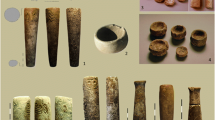Abstract
The sensitivity and applicability of the synchrotron radiation induced X-ray microfluorescence (μ-SRXRF) spectrometer at the Hamburg synchrotron laboratory Hasylab for the determination of the distribution of trace concentrations of rare-earth elements (REE) in fossilized bone are discussed and critically compared to those of other trace analytical methods such as instrumental neutron activation analysis (INAA) and LAMP-ICPMS (laser ablation microprobe inductively-coupled plasma mass spectrometry). Measurements were carried out on two bone samples from contrasting terrestrial depositional environments at Olduvai Gorge (Tanzania). Results indicate that the microdistribution of the REE in these biological materials is not homogeneous and that the relative abundance of these elements can provide information on the palaeoenvironment during the fossilization process. The heterogeneous distribution of the REE can be determined in a quantitative and completely non-destructive manner provided the concentrations of individual REE are above 10 μg/g.
Similar content being viewed by others
Author information
Authors and Affiliations
Additional information
Received: 18 January 1998 / Revised: 6 October 1998 / Accepted: 10 October 1998
Rights and permissions
About this article
Cite this article
Janssens, K., Vincze, L., Vekemans, B. et al. The non-destructive determination of REE in fossilized bone using synchrotron radiation induced K-line X-ray microfluorescence analysis. Fresenius J Anal Chem 363, 413–420 (1999). https://doi.org/10.1007/s002160051212
Issue Date:
DOI: https://doi.org/10.1007/s002160051212




